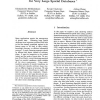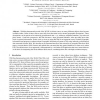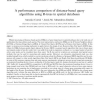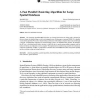1542 search results - page 38 / 309 » Redundancy in Spatial Databases |
VLDB
1998
ACM
13 years 11 months ago
1998
ACM
Many applications require the management of spatial data. Clustering large spatial databases is an important problem which tries to find the densely populated regions in the featu...
GEOINFO
2003
13 years 9 months ago
2003
With the phenomenal growth of the WWW, rich data sources on many different subjects have become available online. Some of these sources store daily facts that often involve textual...
ISCI
2007
13 years 7 months ago
2007
Efficient processing of distance-based queries (DBQs) is of great importance in spatial databases due to the wide area of applications that may address such queries. The most repr...
ICDE
2009
IEEE
14 years 9 months ago
2009
IEEE
Given a set of points P and a query point q, the reverse furthest neighbor (RFN) query fetches the set of points p P such that q is their furthest neighbor among all points in P {...
DATAMINE
1999
13 years 7 months ago
1999
The clustering algorithm DBSCAN relies on a density-based notion of clusters and is designed to discover clusters of arbitrary shape as well as to distinguish noise. In this paper,...




